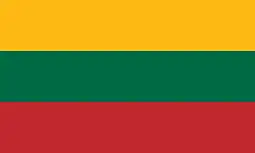Pro-independence movements in the Russian Civil War
Pro-independence movements in the Russian Civil War within the territory of the former Russian Empire sought the creation of independent and non-Bolshevik nation states after the October Revolution, therefore being in direct conflict with the Russian Soviet Republic which sought to conquer them. They were often supported politically or militarily by the Entente Powers. Some of them co-operated with the Russian White movement, but others were in conflict with it. Many pro-independence movements emerged after the dissolution of the Russian Empire and fought in the Russian Civil War.[1]
The following list presents some of the pro-independence movements and the conflicts they were involved in during this period.
Western periphery
 Finland (independence from 1917)
Finland (independence from 1917)
 United Baltic Duchy
United Baltic Duchy
 Baltic State (Lasted from April to September 1918)
Baltic State (Lasted from April to September 1918)- Duchy of Courland and Semigallia (1918)
 Estonia (independence from 1918)
Estonia (independence from 1918)
 Latvia (independence from 1918)
Latvia (independence from 1918)
 Lithuania (independence from 1918)
Lithuania (independence from 1918)
.svg.png.webp) Poland (independence from 1918)
Poland (independence from 1918)
 Ingrian People's Republic (independence March 1917–December 1918; invaded by the Russian SFSR and then partitioned between Finlands and the Ingrian SSR)
Ingrian People's Republic (independence March 1917–December 1918; invaded by the Russian SFSR and then partitioned between Finlands and the Ingrian SSR) Soviet Republic of Naissaar
Soviet Republic of Naissaar.svg.png.webp) Ukraine (independence 1917–1921; invaded by the Russian SFSR and then partitioned between Poland, Czechoslovakia, Romania and the Ukrainian SSR)
Ukraine (independence 1917–1921; invaded by the Russian SFSR and then partitioned between Poland, Czechoslovakia, Romania and the Ukrainian SSR)
.svg.png.webp) Belarus (independence 1918–1919; invaded by the Russian SFSR and then partitioned between Poland and the Belarusian SSR)
Belarus (independence 1918–1919; invaded by the Russian SFSR and then partitioned between Poland and the Belarusian SSR) Crimea (independence 1917–1918; invaded by the Russian SFR, later restored for a short while by the Ukrainian army, invaded and annexed by the Russian SFSR in 1921)
Crimea (independence 1917–1918; invaded by the Russian SFR, later restored for a short while by the Ukrainian army, invaded and annexed by the Russian SFSR in 1921)
 Moldavian Democratic Republic (united with Romania in 1918)
Moldavian Democratic Republic (united with Romania in 1918)
European Russia
- East European Russia
- North European Russia
- South European Russia
 Kuban Rada (formed into April, 1917. Became the Kuban People's Republic in 1918)
Kuban Rada (formed into April, 1917. Became the Kuban People's Republic in 1918) Kuban People's Republic (independence 1918–1920; annexed by the Russian SFSR)
Kuban People's Republic (independence 1918–1920; annexed by the Russian SFSR) Don Republic (independence 1918–1919; annexed by the Russian SFSR)
Don Republic (independence 1918–1919; annexed by the Russian SFSR)
Eastern periphery
 Siberian regionalism
Siberian regionalism
 Evenkia
Evenkia.svg.png.webp) Buryat-Mongolia
Buryat-Mongolia.svg.png.webp) Yakutia
Yakutia Green Ukraine
Green Ukraine Free State of Chukotka
Free State of Chukotka Kamchatka
Kamchatka Tungus Republic
Tungus Republic Far Eastern Republic. (De facto independent 1920-1922; merged with the RSFSR)
Far Eastern Republic. (De facto independent 1920-1922; merged with the RSFSR)
Caucasus
 Transcaucasia
Transcaucasia Azerbaijan (independence 1918–1920; invaded by the Russian SFSR and transformed into the Azerbaijan SSR)
Azerbaijan (independence 1918–1920; invaded by the Russian SFSR and transformed into the Azerbaijan SSR)
.svg.png.webp) Armenia (independence 1918–1921; invaded by the Russian SFSR and transformed into the Armenian SSR)
Armenia (independence 1918–1921; invaded by the Russian SFSR and transformed into the Armenian SSR)
.svg.png.webp) Georgia (independence 1918–1921; invaded by the Russian SFSR and transformed into the Georgian SSR)
Georgia (independence 1918–1921; invaded by the Russian SFSR and transformed into the Georgian SSR)
 Kars Republic
Kars Republic Caucasian Emirate
Caucasian Emirate Mughan
Mughan Centrocaspian Dictatorship
Centrocaspian Dictatorship United Republics (independence 1917–1922; annexed by the Russian SFSR)
United Republics (independence 1917–1922; annexed by the Russian SFSR)
Central Asia
Formerly
- East European Russia
- Central Asia
Legacy
With the exception of the Baltic states, the pro-independence movements were ultimately unsuccessful in achieving their goals, with most territories succumbing to Soviet rule. Pro-independence sentiment remained in exile, with Prometheism being promoted in interwar Poland. National movements reactivated during Glasnost and Perestroika, leading to the dissolution of the Soviet Union and the independence of all constituent republics. Pro-independence sentiment within the borders of the Russian Federation continued to exist, most notably in Chechnya and Tatarstan, and the issue has regained relevance following the 2022 Russian invasion of Ukraine.
References
- Bullock, David (2008). The Russian Civil War, 1918–22 (1st ed.). Oxford: Osprey Pub. ISBN 978-1-84603-271-4.